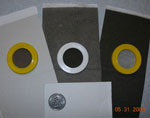The Source of Airborne Lead: Recycling
Pb-Contaminated Soils
summary written by Raven Hanna
The amount of lead particulates in air has decreased significantly as the U.S. began adopting the use of unleaded gasoline and lead limits in the 1970s. Yet, because of the serious health hazards even very small amounts of lead pose to children, some experts believe no amount of lead in our environment is safe. Last year the EPA lowered the allowable lead level in the air by a factor of ten and some have called for an even lower limit. A recent study suggests that to do this one must not overlook the source of lead contamination beneath our feet. The soil serves as a reservoir for lead from the days of leaded gasoline and unregulated manufacturing and may determine a lower limit on the amount of airborne lead.
A research group led by Nicholas E. Pingitore Jr. of the University of Texas at El Paso analyzed soil and air samples from El Paso using SSRL Beam Lines 7-3 and 11-2. To identify the major chemical forms of lead in the air, they subjected 20 samples collected at three sites in 1999 and 2005 to x-ray absorption fine structure experiments. The advantage of using XAFS rather than other techniques is its sensitivity to very small amounts of an element and its ability to identify or characterize different forms or compounds of an element, in this case, lead. They found that the major component of lead in air was in the form of lead humate. Since lead humate forms exclusively in soil, the researchers conclude that the most of the lead in air came from the soil.
The U.S. has seen great reductions in lead contamination - both in the environment and its people's bodies - since it began efforts to reduce lead, but further lowering the levels of lead may be difficult. Greater reduction of the amount of lead in the air cannot be accomplished by solely reducing the current release of lead into the environment by industrial activities, since so much lead already exists in soil and is leaking into the air. But soil remediation is difficult and costly. The researchers suggest that investigation of the bioavailability lead humate, which relates to its health risk potential, will help inform public policy decisions. This work was published by the Public Library of Science ONE.
To learn more about this research see the full Scientific Highlight
Pingitore Jr NE, Clague J, Amaya MA, Maciejewska B, Reynoso JJ (2009) Urban Airborne Lead: X-ray Absorption Spectroscopy Establishes Soil as Dominant Source. PLoS One 4(4): e5019. doi:10.1371/journal.pone.0005019 http://www.plosone.org/article/info:doi/10.1371/journal.pone.0005019.


